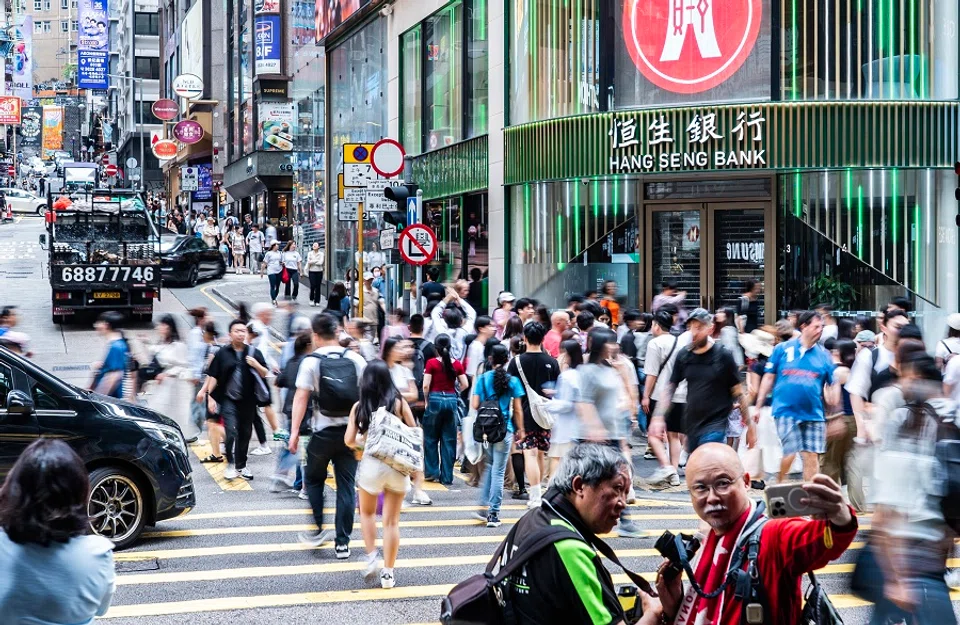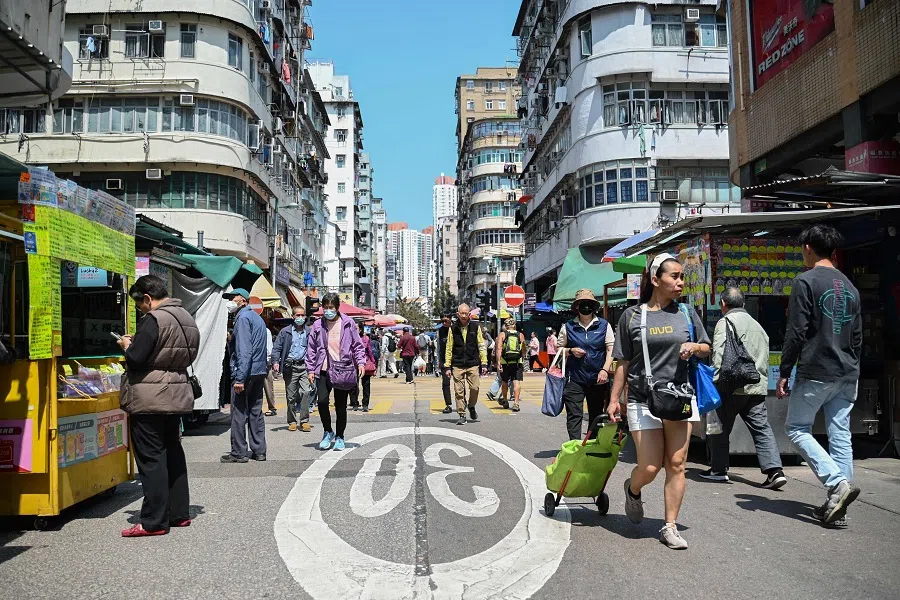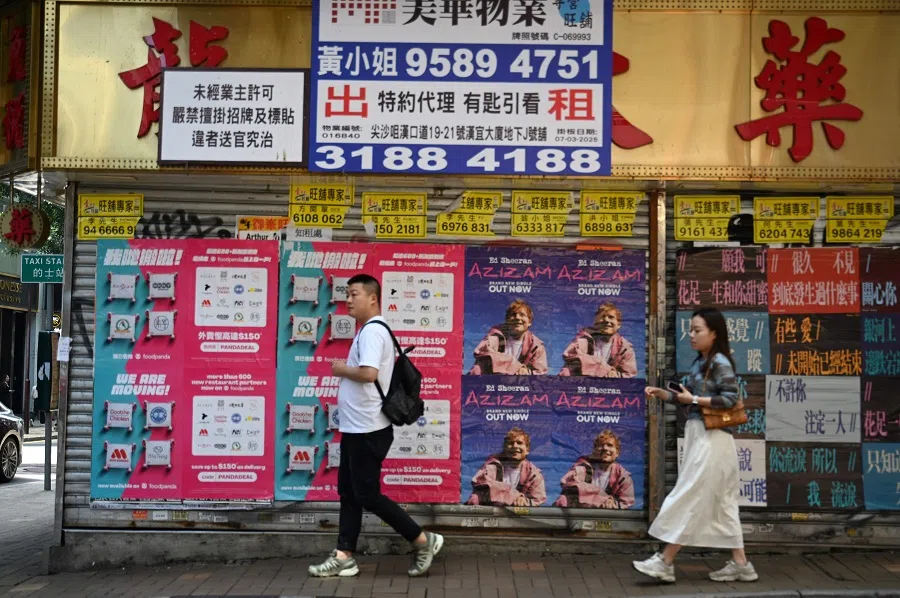[Big read] Is Hong Kong getting overrun by mainland businesses?

Greater integration between Hong Kong and mainland China means that mainland companies are now expanding rapidly to Hong Kong. But what does this mean for local consumers, businesses and culture? Lianhe Zaobao journalist Tai Hing Shing discusses the implications of these developments for Hong Kong.
Yung Wai-yuk, 24, works as an administrative assistant in Hong Kong. She began shopping on mainland Chinese e-commerce platforms over a decade ago when she was still in secondary school.
In an interview with Lianhe Zaobao, she recalled that mainland Chinese products such as clothing were at least 50% cheaper than those in Hong Kong, which is very appealing to Hong Kongers. However, the operations of mainland Chinese e-commerce platforms in Hong Kong were still not fully developed at the time. “It takes more than a week for goods to arrive in Hong Kong after placing an order. The after-sales service was also mediocre. Sometimes, the goods don’t arrive, and complaints go unresolved. You just have to accept you’re unlucky, and that’s about it,” she recounted.
As the e-commerce market developed, the operating model of mainland Chinese e-commerce platforms has significantly improved in recent years; shopping on platforms such as Taobao has become a part of Yung’s life. She now shops on these platforms every week, spending hundreds of Hong Kong dollars (HK$100 is about US$13) each time.
The growth of e-commerce in mainland China
In fact, the e-commerce market in mainland China has experienced rapid growth over the past decade. Major e-commerce giants have not only established strong domestic roots but have also started to expand overseas in search of new growth opportunities.
In the past year alone, the three major e-commerce platforms — Taobao, Pinduoduo and JD.com — have been competing for the Hong Kong market by enhancing shopping experiences, such as offering free shipping, direct shipping and local returns.
Alibaba’s Taobao sparked a free shipping trend starting in October last year. Hong Kong users could qualify for free shipping on designated Taobao products with a minimum purchase of 99 RMB (approximately US$14). Chinese e-commerce platform Pinduoduo subsequently joined the fray, launching a “free shipping to Hong Kong on all products with no minimum purchase” promotion, effectively providing completely free shipping.
Taobao, Pinduoduo and JD.com’s foray into Hong Kong sparked a new wave of consumer enthusiasm, attracting many Hong Kongers to shop on mainland Chinese e-commerce platforms.

In April this year, JD.com entered the Hong Kong market, introducing a “price difference refund” policy for all products sold and fulfilled by the platform. It also offered big subsidies for home appliances, 30-day returns and 180-day replacements for defective items, and free shipping on single-item purchases.
Taobao, Pinduoduo and JD.com’s foray into Hong Kong sparked a new wave of consumer enthusiasm, attracting many Hong Kongers to shop on mainland Chinese e-commerce platforms. I have also observed that many self-pickup points in Hong Kong have recently become “severely congested areas”, with long queues for order collection.
Buying everything and anything online
Yung explained that shipping costs are a key factor for Hong Kong consumers purchasing mainland Chinese products online. By offering free shipping to Hong Kong, platforms like Taobao, Pinduoduo and JD.com have significantly boosted Hong Kongers’ willingness to buy.
She said, “I used to only buy lightweight items such as clothing online. But with free shipping, I now purchase almost all my household and daily necessities — including heavy items like laundry detergent and bulky items like toilet paper — from mainland Chinese e-commerce platforms.”
Hong Kong’s limited land and dense population have led to a city filled with shopping malls, making in-person shopping convenient and popular.

Leung Si-yui, another Hong Konger, also told Lianhe Zaobao that the option of free shipping to Hong Kong has definitely boosted her willingness to shop. It eliminates extra shipping fees and the inconvenience of warehouse consolidation, allowing for faster delivery.
She noted that Hong Kong, being a high-cost area, faces steep prices. With mainland Chinese e-commerce platforms extending free shipping to Hong Kong, many residents have turned to these shopping apps for more affordable goods. Consequently, numerous local businesses in Hong Kong, feeling the pressure, are offering discounts and promotions to retain customers, ultimately benefiting Hong Kong consumers.
Nevertheless, many Hong Kongers still prefer shopping in person. Unlike the online shopping trend that took off in mainland China years ago, Hong Kong’s limited land and dense population have led to a city filled with shopping malls, making in-person shopping convenient and popular.
Untapped online market provides huge opportunities
Data released by the Census and Statistics Department (CSD) of the Government of Hong Kong Special Administrative Region indicated that online sales in Hong Kong currently account for less than 10% of total retail sales volume. In contrast, the online sales market in mainland China is very mature, with an e-commerce penetration rate of nearly 50% — five to six times that of Hong Kong.
Simon Yuen, senior lecturer at the College of Professional and Continuing Education at The Hong Kong Polytechnic University, noted in an interview with Lianhe Zaobao that this yawning gap provided a huge opportunity for mainland e-commerce giants to expand in Hong Kong. The range of products sold by mainland e-commerce platforms includes daily necessities, electronics and household items, offering more choices to Hong Kong consumers.

Yuen explained that mainland e-commerce giants, now operating their own logistics networks instead of relying on companies like SF Express, have significantly reduced costs. To capture the Hong Kong market, these platforms are offering substantial subsidies. “Due to fierce competition,” Yuen predicts, “these discounts will likely persist for at least a year, benefiting Hong Kong consumers with lower prices while also fostering closer integration between Hong Kong and the mainland.”
... the provisional estimate of total retail sales in March was only HK$30.1 billion — a 3.5% drop year-on-year, marking a consecutive 13-month-long decline.
Hong Kong retail stores face ‘ice age’
The Hong Kong retail industry has long faced challenges stemming from high wages, rent and commodity prices, with business worsening in recent years due to the Covid-19 pandemic. Mainland e-commerce platforms targeting the Hong Kong market by offering “free shipping” discounts might be a boon for consumers, but it has caused an unprecedented “ice age” for local retail stores. According to the latest statistics released by the CSD, the provisional estimate of total retail sales in March was only HK$30.1 billion — a 3.5% drop year-on-year, marking a consecutive 13-month-long decline.
Hong Kong’s e-commerce platforms have responded proactively to compete with their mainland counterparts. HKTVmall, the leading local platform, eliminated all minimum purchase requirements for self-pickup as of April 1st. Customers can now collect any order for free at O2O (online-to-offline) locations or partner pick-up points.
Another local e-commerce platform, Yoho Group, launched the “Lightning Delivery” in April, which included one-hour store pick-up, same-day delivery and next-day delivery for large home appliances.
Yuen pointed out that although mainland e-commerce platforms are aggressively expanding into Hong Kong, there remains a segment of the population — especially the elderly — who prefer offline shopping. This suggests that the local retail industry still has room to survive. However, advancements in logistics and payment technologies, along with the availability of high-quality, affordable products from mainland e-commerce, mean that online shopping is likely to become the mainstream consumer model in Hong Kong over time. This shift will inevitably impact local retailers, particularly small and medium-sized businesses.
Hong Kong’s e-commerce platforms might also focus on high-quality products, exclusive brands or speciality products to differentiate themselves from mainland e-commerce’s “low-price strategy”.
How can local retailers compete?
On top of retailers, local Hong Kong e-commerce platforms face competitive pressure from their mainland counterparts and need to adopt retaliatory strategies, Yuen added. He suggested that local e-commerce platforms enhance their “same-day delivery” services by fully utilising Hong Kong’s logistics network to provide a faster delivery experience.
Hong Kong’s e-commerce platforms might also focus on high-quality products, exclusive brands or speciality products to differentiate themselves from mainland e-commerce’s “low-price strategy”. “For instance, HKTVmall focuses on both local and international brands, offering global boutique selections to attract different consumer groups,” said Yuen.

In the future, Yuen feels that Hong Kong e-commerce platforms should strengthen cooperation with mainland suppliers in order to reduce cost and enhance competitiveness. They should also make use of artificial intelligence and big data analytics to enhance customer experience by offering personalised promotions and discounts tailored to the Hong Kong market, which would in turn help sustain development for local e-commerce platforms
Hong Kong’s local flavour risks dilution
Besides e-commerce, companies from various sectors in mainland China have been entering the Hong Kong market in recent years, gradually influencing the daily lives of Hong Kongers in areas such as clothing, food, housing, and transportation.
Take food delivery. For the past decade, the Hong Kong market was dominated by two foreign-owned platforms — British-backed Deliveroo and German-owned foodpanda. That changed in 2023 when mainland delivery giant Meituan entered the Hong Kong market under the brand name Keeta, sparking fierce market competition.
As for Hong Kong’s ride-hailing sector, American company Uber has operated in the city for over a decade. But in recent years, platforms from mainland China and Singapore have entered the fray.

In May 2023, Keeta announced a HK$1 billion promotional campaign to attract customers. In addition to distributing HK$300 worth of vouchers, it also introduced a free delivery program to entice users to sign up for membership. Keeta’s aggressive spending strategy quickly paid off — within just one year, it had captured a 44% market share, surpassing both foodpanda and Deliveroo to become the top platform in Hong Kong. On 7 April this year, the defeated Deliveroo announced its exit from the Hong Kong market.
Cash-burning strategies in the ride-hailing sector
As for Hong Kong’s ride-hailing sector, American company Uber has operated in the city for over a decade. But in recent years, platforms from mainland China and Singapore have entered the fray. Following Keeta’s success in dethroning Deliveroo, many believe that ride-hailing will be the next battleground for mainland firms.
In May last year, Alibaba’s Amap (Gaode) entered the Hong Kong market, initially offering only e-hailing taxi services. However, the company recently expanded into private car-hailing and began issuing cash vouchers to lower ride fares, making some trips even cheaper than Uber. This was a move clearly aimed at challenging Uber’s dominance.
In addition to Amap, mainland ride-hailing giant Didi has also entered the Hong Kong market, though it currently only offers taxi and cross-border vehicle booking services and has not posed a major threat to Uber. But on 28 April, Didi announced plans to launch a new “economy” online private car-hailing service in Hong Kong, signalling its ambition to seize a larger market share.
... as China’s economic growth slows and domestic consumption weakens, many industries have been grappling with overcapacity. As a result, a number of local brands have adopted a “go global” strategy to stay afloat. — Chan Wai-keung, Lecturer, Hong Kong Community College, Hong Kong Polytechnic University

Market observers anticipate that Uber, Amap and Didi are likely to engage in a “cash-burning war” in the near future, entering a zero-sum game of fierce competition. In the short term, this may benefit consumers through lower prices and better promotions.
Competition also heats up in the real estate market
In real estate, Hong Kong’s market is currently dominated by two major local agencies — Centaline Property and Midland Realty — which together hold the lion’s share. Mainland Chinese real estate brand Qfang.com entered the Hong Kong property agency sector in 2015 with bold ambitions, claiming it would invest over HK$600 million (US$76.7 million) and recruit 7,000 frontline agents to challenge the duopoly of Centaline and Midland.
However, Hong Kong’s property market remains uniquely traditional and heavily reliant on physical, in-person agency services. This presented a major challenge for Qfang, which significantly scaled back its Hong Kong operations by 2021. The company eventually transitioned to a franchise store model in the local market.
In an interview with Lianhe Zaobao, Chan Wai-keung, a lecturer at the Hong Kong Community College of the Hong Kong Polytechnic University, noted that as China’s economic growth slows and domestic consumption weakens, many industries have been grappling with overcapacity. As a result, a number of local brands have adopted a “go global” strategy to stay afloat.

He explained that Hong Kongers possess strong spending power, and with the post-pandemic trend of travelling north for shopping and services, local consumers are becoming increasingly open to mainland products. For many mainland enterprises, this makes Hong Kong — which is culturally similar — an ideal testing ground before venturing further into global markets.
Mainland and Hong Kong enterprises meet in the middle
Chan noted that the wave of mainland enterprises entering Hong Kong also has to do with the current political climate. Since the 2019 extradition bill protests, the Greater Bay Area has entered a new phase of deep integration. Governments on both sides of the border have ramped up policy support for closer ties between mainland and Hong Kong businesses, expanding interconnected flows of capital and logistics.
He felt that with deeper integration between the mainland and Hong Kong, businesses from both regions are actively expanding “northward and southward”, which benefits Hong Kongers. “When I dine out, I find that some mainland restaurant brands offer high-quality food at affordable prices — that’s something Hong Kongers can benefit from.” However, he also acknowledged that in this development process, Hong Kong’s unique local character may gradually become diluted.
This article was first published in Lianhe Zaobao as “大陆电商免运费风球 掀起港人网购新热潮”.





